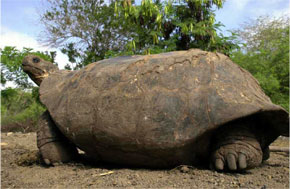GIANT TORTOISES
The
most famous inhabitants of the Galapagos Islands are without doubt
the Giant Tortoises. The islands were first named by Spanish sailors
‘Las Islas Galapagos’ or the ‘Tortoise Islands’.
In 1892 the government of Ecuador officially changed the name to |
 |
‘Archielago de Colon’ or ‘Archipelago of Columbus.But
Galapagos has always stuck. The hatchlings weigh less than a quarter of a pound. It takes 20 years to reach full-grown, after which they still grow, but slowly. A full grown male can reach six feet long and weigh over six hundred pounds. It is not known how long the giant tortoise lives but it is thought to be at least 150 years. Harriet, a wild caught tortoise, supposedly by Charles Darwin, is now in an Australian zoo, and has documented proof that she has been there since at least 1877. Making her well over 150 years old. Each of the races is totally restricted to a specific island or, in the case of the five races of Isabela Island, restricted to a particular volcano. |
|
There are two main categories of giant tortoise on Galapagos:
The
first has a rounded dome-shaped shell with short legs and neck.
These are usually found on islands with higher elevations, such
as Santa Cruz, San Salvador and San Cristobal, and eat low growing
vegetation. |
 |
 |
The
second have saddle-shaped shells with long legs and neck. They
feed on branches and fruit such as the fruits of the giant prickly
pear cactus. They are found on islands with large dry areas where
vegetation is sparse like Pinta and Espanola. |
Once 14 races of subspecies of Galapagos giant tortoise inhabited the islands. But that was before the arrival of man. Three of them are now extinct; the 11 remaining vary in number from the Alcedo tortoise from the central volcano of Isabella which numbers over 5,000, to ‘Lonesome George’.
Lonesome George is the last of his species from Pinta. He is now in the Charles Darwin Research Centre, to keep him safe. He has been introduced to two females from Volcan Wolf volcano on Isabella, but they have not attempted to mate.
Geneticists are at the moment trying to find a closer match for George to mate with. If it works they believe that the offspring, once put back on Pinta, would once again be subject to Darwins natural selection and it would not be too long before the subspecies would be what it once was.